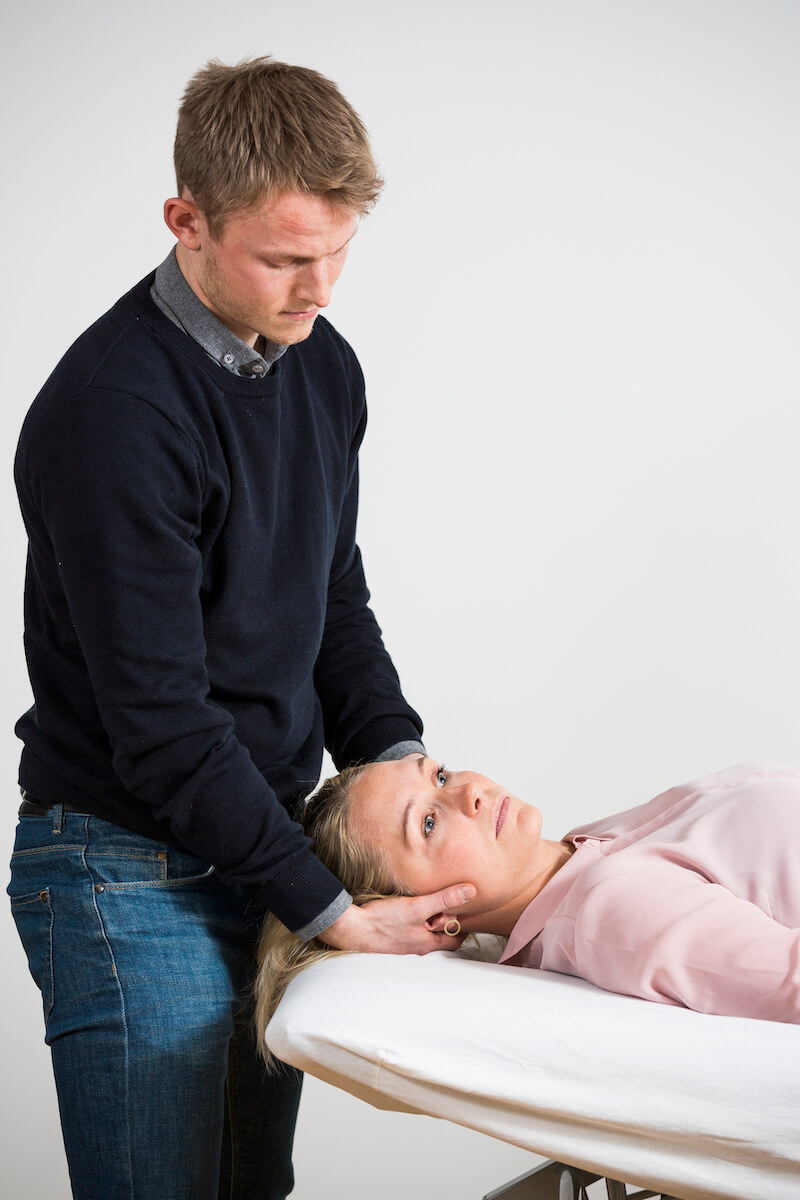We treat
Carpal tunnel syndrome
Learn more about Carpal Tunnel Syndrome and its treatment
What is carpal tunnel syndrome?
Carpal tunnel syndrome (CTS) is a condition that occurs when the median nerve, which runs from the forearm into the palm of the hand through an area called the carpal tunnel, becomes pinched or compressed. The carpal tunnel is a narrow passageway in the wrist, formed by the bones of the wrist and a thick band of connective tissue called the transverse carpal ligament. Within this tunnel run several structures, including the flexor tendons and the median nerve.
Jump to section [Vis]
Causes of carpal tunnel syndrome (CTS)
CTS is a condition that can cause discomfort and limitations in hand function due to compression of the median nerve in the wrist, specifically the carpal tunnel. The carpal tunnel is the place in the wrist where the flexor tendons of the hand and the median nerve run through. If the space in the carpal tunnel becomes too narrow for one reason or another, increased pressure may be created on the nerve that supplies parts of the hand and some of the fingers.
One of the most common causes of CTS is irritation and inflammation of the tissue around the carpal tunnel.
This irritation, also called inflammation, can cause fluid to accumulate and swell the tendon sheaths that enclose the flexor tendons in the tunnel, resulting in increased pressure on the median nerve. This pressure will manifest itself in symptoms that spread to the hand and several of the fingers that the nerve supplies.
The causes of the development of CTS can include repetitive stress, for example repetitive wrist movements in connection with work or sports that result in tendon irritation and lead to the process described above.
In addition, conditions such as rheumatoid arthritis, pregnancy, low metabolism and diabetes can increase the risk of developing CTS. The condition can also occur as a result of other conditions or injuries, such as a wrist fracture or due to congenital anatomical conditions where the carpal tunnel is narrowed and therefore increases pressure on the nerve. (Source: Sundhed.dk).

Symptoms of carpal tunnel syndrome
- Pain or discomfort in the wrist, hand, or fingers, especially at night.
- Numbness or tingling in the hand, especially in the thumb, index, middle and half of the ring finger.
- Weakening of the muscles of the hand, which can cause difficulty gripping objects or performing fine motor tasks.
- Increased sensitivity or “pins and needles” sensation in the hand or fingers.
- Symptoms worsen during activities that involve repetitive hand movements such as writing, using tools, or handling small objects.
- The feeling of having an “itchy” or “burning” sensation in the hand.
It is important to note that the symptoms of CTS can develop gradually over time and can range in intensity from mild to severe. Some people only experience occasional symptoms, while others may have constant discomfort and limitations in hand function.
Diagnostic methods
Diagnosis of carpal tunnel syndrome (CTS) is based on a combination of symptom history, physical examination, and in some cases, additional tests.
We will always assess your symptoms from a holistic perspective and not just focus on your wrist. We will work with you to try to determine where your symptoms originate and when and how they started.
History and physical examination
We will always start by asking about your medical history and asking about your symptoms, including pain, numbness, tingling or weakness in the hand and fingers. We will then perform a thorough examination, which includes assessing the strength, sensitivity and function of the hand and fingers, as well as examining the rest of the body.
Tinel’s test
One of the tests we will perform to get closer to the diagnosis is Tinel’s test, where the carpal tunnel area is gently tapped to see if this causes the above symptoms. If this is the case, the test is positive and, combined with symptoms and other tests, may indicate that it is carpal tunnel syndrome.
Phalen’s test
Another test that may help indicate the diagnosis is asking the patient to bend their wrists and hold them together for 30-60 seconds. If this triggers or worsens symptoms, this test is positive.
Nerve conduction study (electromyography and nerve conductivity test)
If the above tests are not conclusive for the diagnosis and/or if there is doubt, your doctor may refer you to a nerve conduction study by a neurologist, which measures the speed and strength of nerve impulses along the median nerve. In CTS, these tests will most often show delayed nerve conduction and impaired nerve function, which can confirm the diagnosis.
Diagnostic imaging
In rare cases, imaging studies such as ultrasound may be used to assess the condition of tissues in and around the carpal tunnel, but these are usually not necessary and are rarely performed for the diagnosis of CTS.

Treatment options
The treatment of CTS aims to reduce discomfort and symptoms and prevent progression and loss of hand function. Relief, weight reduction and immobilization of the wrist are the first steps, as this will help to relieve the irritation and the resulting swelling in the carpal tunnel, which causes increased pressure on the median nerve.
- Wrist splint: A rigid splint with the wrist in a neutral position can relieve symptoms in most people within a few days, but the effect is often not lasting.
- Hand exercises: Certain exercises and stretches can strengthen the muscles around the wrist and help reduce the symptoms of carpal tunnel syndrome.
- Nonsteroidal anti-inflammatory drugs (NSAIDs): Known as ibuprofen, they can reduce the irritation (inflammation) around tendon sheaths and relieve pain. Always talk to your doctor before treatment.
- Corticosteroid injections: If relieving the wrist with a splint and exercises is not effective enough, a corticosteroid injection into the carpal tunnel can be tried, which will reduce the inflammation. However, this effect is temporary for the vast majority of people.
In some cases, symptoms can also originate from other structures in, for example, the neck, which, due to reduced mobility, can lead to reduced nerve function and supply to the arm. The examination and treatment of the rest of the body will therefore always be part of the consultation when you come to us.
Surgical procedures
Rarely, surgery may be necessary. Such an operation will be performed under local anesthesia, where the doctor will apply anesthesia to the underside of the wrist. During the operation, the doctor will split the tendon on the underside of the wrist, exposing the nerve. The wound will be sewn together and a band-aid will be applied. In addition, you will be given a larger dressing with cotton wool and elastic bandages to prevent swelling.

Rehabilitation exercises after treatment
Finger stretches:
– Gently stretch each finger individually by gently pulling it back towards the wrist for about 10 seconds. Repeat this with each finger on both hands.
– Hold your hands out in front of you with your fingers spread and gently press against your fingers with your opposite hand to spread your fingers apart.
Wrist stretches:
– Hold your arm out in front of you with your palm facing down. Use your opposite hand to pull your fingertips toward the floor until you feel a stretch in your wrist. Hold for 10-15 seconds and repeat on the other side.
– Repeat the stretch, but this time with your palm facing upwards.
Wrist circles:
– Lav langsomme cirkulære bevægelser med håndleddet, først med uret og derefter mod uret. Gør dette i 10-15 gentagelser på begge hænder.
Grip exercises:
– Crush a ball or rolled up towel with your hand for 5-10 seconds and then release. Repeat this 10-15 times with both hands.
– Use a rubber band and spread it between your fingertips. Slowly open your fingers while resisting the elastic. Repeat 10-15 times.
Hand and finger exercises with a stress ball:
– Crush a small ball repeatedly for 5-10 seconds at a time and then relax. Repeat this 10-15 times with both hands.
Remember; the exercises should not hurt and they should be discontinued if pain occurs. Then wait a few hours and try again. The exercises can be repeated 2-4 times daily.
Source: National Library of Medicine
Preventing carpal tunnel syndrome
Avoid direct cold on your hands and wrists. It may be a good idea to change positions frequently at work. For example, if you sit at a computer a lot, it may be a good idea to use a wrist rest. Make sure to move your hands and wrists occasionally to avoid static positions for too long at a time.
Long-term effects and management:
The condition resolves spontaneously in about one in three people. Since the condition has the potential for spontaneous recovery in many cases, surgery should be avoided if possible, especially if the symptoms are mild and short-lived. Symptoms associated with pressure on the median nerve during pregnancy typically improve after delivery as fluid retention in the body resolves.
If symptoms persist, you should consider treatment.
If you experience significant symptoms that are not relieved by relief or using a splint, you should consult an osteopath or your doctor.

Often related problems

Jaw joint pain

Vitamin deficiency – spot & control the symptoms

Trigger finger

Carpal tunnel syndrome

Sprains

Tenosynovitis

Nerve pain

